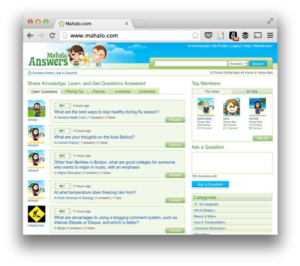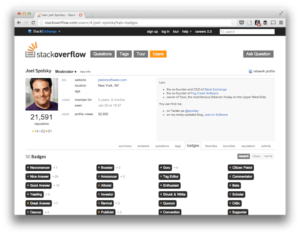
Earlier this month, Twitter co-founder Biz Stone unveiled his mysterious startup Jelly. The question-and-answer app was met with a mix of criticism and head scratching. Tech-watchers asked if the world really needed another Q&A service. Skeptics questioned how it would compete with existing solutions and pointed to the rocky history of previous products like Mahalo Answers, Formspring, and Aardvark.
In an interview, Biz articulated his goal to, “make the world a more empathetic place.” Sounds great but one wonders if Biz is being overly optimistic. Aren’t we all busy enough? Control for our attention is in a constant tug-of-war as we struggle to keep-up with all the demands for our time. Can Jelly realistically help people help one another? For that matter, how does any technology stand a chance of motivating users to do things outside their normal routines?
We hope a few insights gleaned from user psychology may help the Jelly makers improve their jam and provide some tips for anyone building an online community.
Lesson 1 – The Right Reward
In May 2007, entrepreneur and Internet celebrity Jason Calacanis launched a site called Mahalo. A flagship feature of the new site was a Q&A forum known as Mahalo Answers. Unlike previous Q&A sites, Mahalo utilized a special incentive to get users to ask and answer questions.

People who submitted a question would offer a bounty in the form of a virtual currency known as “Mahalo Dollars.” Then, other users would contribute answers to the question and the best response would receive the bounty, which could be exchanged for real money. By providing a monetary reward, the Mahalo founders believed they could drive user engagement and form new habits.
At first, Mahalo garnered significant attention and traffic. At its high point, 14.1 million users worldwide visited the site monthly. But over time, usage stalled.
Calacanis blamed Google’s algorithm update for having a major negative impact but said Mahalo was, “growing very slowly” even before the change. As Mahalo struggled to retain users, another Q&A site began to boom. Quora, launched in 2010 by two former Facebook employees, quickly grew in popularity. Unlike Mahalo, Quora did not offer a single cent to anyone answering questions. Why then, have users stayed engaged with Quora but not with Mahalo, despite its monetary rewards?
In Mahalo’s case, executives assumed that paying users would drive repeat engagement with the site. After all, people like money, right?
However, Quora demonstrated that social rewards and the variable reinforcement of recognition from peers proved to be a much more salient motivator. Quora instituted an upvoting system that reports user satisfaction with answers and provides a steady stream of social feedback. Quora’s rewards have proven more attractive than Mahalo’s because the incentive to answer a question is driven by the anticipation of social, not financial, reward. When it comes to online communities, the need to connect and contribute turns out to be a more powerful motivator than collecting cash.
Lesson 2 – Frequency Matters
Think of the products and services you would identify as “habit-forming.” Odds are most of these services are used daily, if not multiple times per day. For instance, in December of 2013, a remarkable 61.5 percent of Facebook’s 1.23 billion monthly active users returned to the site at least once per day. A survey conducted by IDC revealed Americans checked Facebook an average of 14 times per day.
When it comes to forming habits, frequency matters and studies have demonstrated that how often a behavior occurs is a key factor in the likelihood of creating a new routine.
On Mahalo, only one person was awarded the monetary bounty, often days after submitting their answer. If payouts were meant to take the form of a game, then the rewards came too infrequently to matter. The same can be said for those asking questions. Relative to the results delivered by Google, Mahalo Answers took an eternity. Services that can deliver quick rewards encourage higher frequency of use and have an easier time forming new habits.
Though still not as fast as a Google search, Jelly provides feedback relatively quickly. It is not surprising given his Twitter pedigree that Biz Stone understands the power of frequent interactions. On Twitter, the feedback is fast and often furious — a single tweet can generate favorites, retweets, and replies within seconds. For Jelly to succeed, users must receive frequent reinforcement.
Within 60 seconds of submitting the question, “Why do you use Jelly?” four people responded, pulling me back to the app before my grip left my iPhone. When asking a question on Jelly, friends and friends-of-friends receive a push notification, prompting the recipients to help.
Unfortunately, to get the notifications, users need to have the app. As one would expect of a fledgling service, Jelly has not yet reached the critical mass of people needed to provide the quick Twitter-like feedback users crave. For the reward to come fast enough, not only does Jelly need enough users, but it must also build the right kind of community.
Lesson 3 – A Community of People Whose Opinions We Care About
We are a species that depends on each other. Social rewards are driven by our connectedness with other people. Our brains are adapted to seek rewards that make us feel accepted, attractive, important, and included. Many of our institutions and industries are built around this need for social reinforcement. From civic and religious groups to spectator sports and “water cooler” television shows, the need to feel social connectedness informs our values and drives much of how we schedule our time.
Sites that leverage these kinds of rewards benefit from what psychologist Albert Bandura called “social learning theory.” Bandura studied the power of modeling and ascribed special powers to our ability to learn from others. In particular, Bandura showed that people who observe someone being rewarded for a particular behavior are more likely to alter their own beliefs and subsequent actions.
However, social rewards are not as meaningful if they come from just anyone. Notably, Bandura showed that when people observe the behavior of people most like themselves, or those who are slightly more experienced, social learning worked particularly well. This is exactly the kind of targeted demographic and interest-level segmentation that industry-specific sites such as Stack Overflow apply.
Stack Overflow, the world’s largest Q&A site for software developers, generates a staggering 5,000 answers to member questions daily. Many of these responses provide detailed, highly technical and time-consuming answers. Users invest effort into what others may see as the burdensome task of writing technical documentation.
Like Quora users, Stack Overflow users are not rewarded with money, but recognition within the community. Each time a user submits an answer, other members have the opportunity to vote the response up or down. The best responses percolate upwards, accumulating points for their authors. When they reach certain point levels, members earn badges, which endow special status and privileges.

Stack Overflow works because, like all of us, software engineers find satisfaction in contributing to a community they care about; turning a seemingly mundane task into an engaging, game-like experience. But on Stack Overflow, points are not just an empty game mechanic, they confer special value by representing how much someone has contributed to their tribe. Users enjoy the feeling of helping their fellow programmers and earning the respect of people whose opinions they value.
Jelly: Sweet or Sour?
Will Jelly succeed where other Q&A services failed? It is always hard to predict the success or failure of new still evolving products. We hope Jelly and other community-oriented sites will take lessons from the examples above to provide frequent, meaningful rewards from a community that users care about. By looking to insights from psychology, product designers can increases their odds of forming new user habits.
Note: I’ll be speaking at the Habit Summit. Use the discount code “NirAndFarFriends” for $50 off.
Image via Shutterstock
Related Articles
- Schedule Maker: a Google Sheet to Plan Your Week
- Cancel the New York Times? Good Luck Battling “Dark Patterns”
- How to Start a Career in Behavioral Design
- A Free Course on User Behavior
- User Investment: Make Your Users Do the Work
- Variable Rewards: Want To Hook Users? Drive Them Crazy
- The Hooked Model: How to Manufacture Desire in 4 Steps
